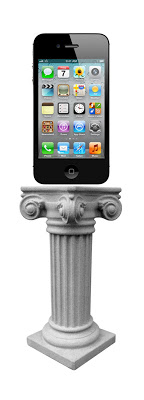
Or maybe it’s because, at the same time, Steve Jobs had just said that mobile advertising “sucks”. Agreeing with the wisdom of Jobs has hardly ever been newsworthy, attention-getting or memorable. Disagreeing with Jobs seems foolish, especially in the posthumous honeymoon period. What I remember most about the article that the quote came from [3] is Jobs looking positively cadaverous in the accompanying photo. I didn’t read the story behind that headline either.
First, what’s all the excitement about, other than mobile clearly being the Next Newest Thing in marketing? Well, in context, mobile just might save the world, but you need to know that the first article referred to above is talking about the developing world. For much of the developing world, smart phones supplant the personal computer. Why? Because smart phones are way cheaper than computers and can do many of the same things on the Internet. And before mobile networks, there was very little telephone line and/or cable infrastructure to support Internet use by the public. In developing countries, mobile is the Internet, and since half that world is under 30 years-of-age, users are very comfortable with their tiny little screens and keypads. And to the journalist’s credit, mobile won’t be saving the world by selling it Coke and Big Macs, it will be by connecting the developing world to the true wonder of the Internet: instant, mass communication (without censorship, in the luckier developing countries), education and the arts.
For North American marketing people, there seems to be a direct co-relation between excitement level and the proximity of marketing messaging to the sales transaction—at least where new technology is involved. What’s interesting here is that mobile devices are actually becoming the sales transaction device. Less than 12-months after Starbucks launched its mobile payment program (Jan, 2011), it reached 26 million transactions. And this was just by providing an app for loading Starbucks cards, which is only available via mobile download. For Starbucks, and brands like it, that’s worth getting excited about.
Let’s look at the Jobs’ comment in context. It was made at press conference in which Apple’s new iAd advertising platform was being introduced. Designed for iPhones and iPads, iAd offers better graphics and richer functionality by placing ads in applications, rather than delivering ads through mobile search results like Google does. As part of pitching iAd, what Jobs actually said was, “We think most of this (Google’s search-based) mobile advertising really sucks. We think Apple could make some contributions.” This is fairly tame for Jobs, never one to shy away from being directly and graphically competitive when shilling his own innovations. Yes, you could say mobile advertising sucks creatively, or you could say it’s still in a relatively primitive stage of development, like web advertising once was, and like using Twitter as an advertising medium still is.
Here’s what I think about mobile:
- It’s a nice extension of the web, but you need to make sure your web-based creative is mobile phone & tablet friendly. This means sizing, simplicity and scripting beyond Flash for the rising tide of Apple users out there. Marketers need to do this before they dive into apps, and a surprising number are still skipping this critical first step.
- Mobile isn’t for everyone. Obviously brilliant for mobile phone companies and tablet companies. Also great for brands like Starbucks where there is a strong impulse component to purchase, where reaching a consumer very close to the point of sale can make a sale happen. When entertaining a mobile initiative, every marketer needs to first do a thorough purchase decision analysis.
- Like social media, mobile is another media—or a media extension—and as such, will always work better as part of an integrated campaign.
- At the retail level, mobile’s potential as a selective couponing device is huge, espeically in combination with email-based couponing campaigns like Gap is using.
- In Europe, location-based/near-field message broadcasting (usually based on Bluetooth communication technology) to mobile devices is a powerful combination of traditional and new media strengths. North American privacy concerns may mean that this amazing media technology may never reach its potential here.
- Content is everything, and it needs to be brutally simple in mobile. Old-fashioned copy writing is king, which is really kind of cool.





